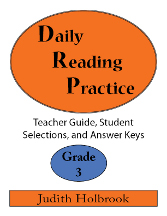The Daily Reading Practice series helps students in grades one through ten develop a surprisingly broad range of reading skills. Each week, students read and reread a short passage then practice a variety of language arts skills based primarily on the reading passage. Daily activities for the week are repeated with a different passage each week. Some activities will be led by the parent or teacher while some will be completed independently. With two or more children, you will probably work through some activities together. Younger children will definitely need more interaction. On some days the activities will take just a few minutes while others will require more time.
Each week’s activities build progressively upon the previous weeks' lessons. During each week, each day’s lesson begins with students reading the same literary passage. For example, in fifth grade, students begin on Monday by identifying the subject of the passage, the author’s purpose, and the genre, and they create their own title for the passage. On Tuesday, they work on vocabulary to identify synonyms, antonyms, base words, definitions, and contextual meanings. Wednesday is devoted to reading skills such as inferences, reading comprehension, understanding idioms, identifying the “conflict,” and using visualization skills to draw something mentioned in the passage. On Thursdays, students identify the main idea, the topic sentence and details, and the author’s viewpoint. On some Thursdays, they might, instead, practice “skimming,” use graphic organizers to clarify information in the passage, or work with figurative language. On Friday, students identify keywords in the passage then write their own summary of the passage from those keywords.
The activities I have described for fifth-grade level are simplified and limited for younger students and expanded for older students. For example, on Mondays, first graders listen to the passage as it is read aloud, discuss what the passage is about, and work with the parent or teacher to come up with a title. In contrast, tenth graders take it up a notch or two from what I’ve described for fifth grade by also doing such tasks as identifying the author’s tone, identifying genres from a broader list, and writing definitions of idioms.
For each level, there is a teacher guide as well as a student workbook. The teacher guide begins with a few pages about using the course that you really should take time to read. These pages are followed by Help Pages (which are also included in the student workbooks) that provide notes for completing the tasks for each day. Think of these pages as a quick reference guide. Both students and teachers might need to refer to these notes throughout the course.
The teacher guide also includes copies of each week’s reading passage in a larger font. These are most useful in a class or group situation where students do not have individual workbooks. However, student workbooks are very inexpensive, so I expect most homeschool students will work directly in workbooks.
Following the reading passages in the teacher guide are the answer keys. These are identical to student pages but with all of the answers overprinted. Suggested keywords and summaries are provided for Friday’s lessons, and graphic organizers are shown for some of Thursday’s assignments. The layout makes it easy for the teacher or parent to guide students through each day’s activities. On the other hand, the layout is my only area of complaint. Each week’s activities, including the reading passage, are all presented on a single page at every grade level. Since first graders have briefer reading passages and fewer assignments, the font is relatively large and the pages don’t appear overly crowded. The pages gradually become more crowded. While this is okay through the middle grades, by tenth grade, the font has gotten very small, and pages are quite crowded. Some students won’t have trouble with this, but others might. You can view free sample pages on the publisher’s website in advance so you can judge for yourself.
While there are other reading skills resources that tackle some of the objectives addressed in Daily Reading Practice, I don’t know of anything else that does such a comprehensive job. By focusing on the same reading passage every day for a week, students learn to read closely and develop skills in finding and retaining information. But moving beyond reading comprehension, Daily Reading Practice also works on vocabulary, literary analysis, critical thinking, and composition.
One might question the value of working with the same reading passage for an entire week, but the variety of exercises that work with the material in such different ways teach an attentiveness in reading that students seldom experience.








